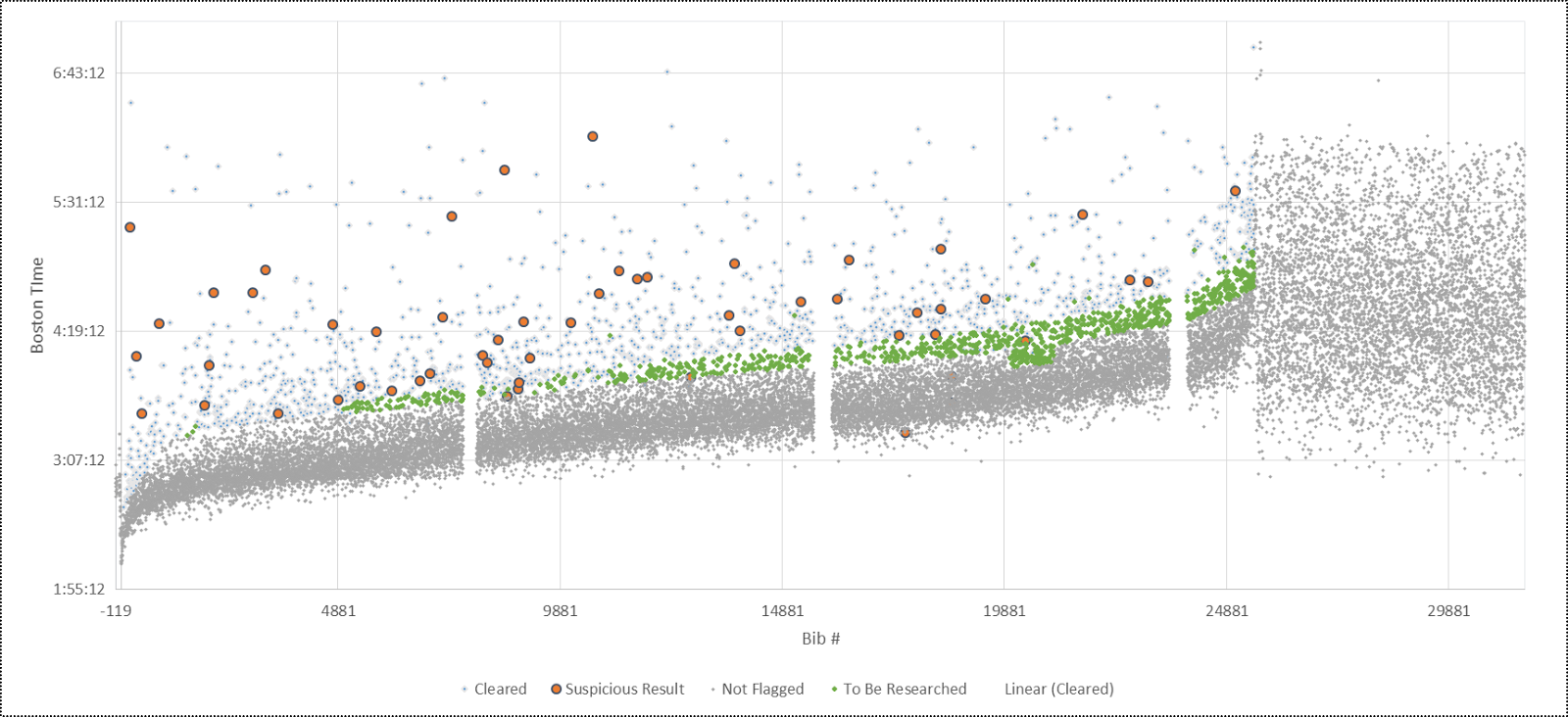The Original “Boston Project”
The idea for a detailed review of Boston finishers began well after the 2015 Boston Marathon. This was after Mike Rossi was very publicly outed for cutting the course in his 2015 Boston Qualifier. The massive thread that followed on letsrun.com was the impetus for my initial blog.
Initially, I would just look at random races looking for obvious cases of cheating and I would post about those cases, and report those runners to races. What was unknown, was how many runners cheat, and use those times times to enter Boston.
I wanted to know how many Mike Rossi’s were there? If the runners I was catching and identifying were not using those times to enter races like Boston, was it really worthwhile to go through the trouble of combing results?

With a lot of help and guidance from a small group of runners that I connected with from the letsrun thread, the basic methodology was developed.
Boston issues bibs based on runners’ qualifying time. Because of this, we were able to estimate within a few seconds, what a runner’s qualifying time was based on the assigned bib number. Plotting Boston finishing time against bib number provides a good visualization of this. The red dots were those that were determined to have cheated either by cutting, using a bib mule, or running with a bib that was not assigned to them.

Essentially, we compared Boston finish time vs. qualifying time. The outliers were the ones that were prioritized for review. If a runner qualified in 2:45:00 and ran a 5 hour Boston Marathon, they were ‘flagged’ for review.
The review process was tedious. There were initially about 4 of us going through the review, eventually it was just me. At the top end of the prioritized list, we found quite a few likely cheaters (still just about 10%). As we got further down, the percentage of cheaters decreased. I owe a lot to Runner’s World. One of the members of the group that helped investigate results made the writer aware of the project, and when they contacted me, it motivated me to keep plugging away with the investigation.
Refining The Process
The initial review was meant to just gather data, to get a feel for whether a significant number of runners cheated to get into Boston. Based on time and availability of data, some things weren’t accounted for which are now part of the process in flagging runners.
Average Boston Times
- Race conditions – the past 2 years were relatively hot.
- Spring Marathons – For many, training for an early spring marathon is difficult. There is snow and cold to deal with.
- “Victory Lap” – Some runners put the most effort to qualify. They run Boston to enjoy it – it is the reward for their hard work. They aren’t aiming for a PR or to re-qualify while at Boston.
- Qualifying race – In the initial review, many of the runners that were at the top of the list qualified at the most extreme of downhill marathons. When the list was put together, I did not have qualifying information – I was filtering through a large number of runners that qualified at St George, Tunnel Marathons, and Revel Marathons.
Instead of looking at the variance based on qualifying time, I now generate a ‘predicted time’.
Calculating Predicted Time:
Last year, on average, runners finished Boston about 11.25% slower than they qualified. Males were 12.4% slower and females were 9.9% slower. By default, I will adjust males and females predicted time based on these variances for The 2018 Boston Marathon.
To account for the qualifying races, I pull data from the races that send the most runners to Boston, as well as the ‘easiest races’ that I’ve previously identified. I look the variances between runners qualifying times and Boston for each of these races specifically, and adjust my predicted times appropriately. This process adequately adjusts the predictions so that runners in these races didn’t disproportionately come up for review.
I Don’t Think You Cheated
Every year, I get emails from runners that either planned to take it easy, or had a bad day. Typically they go into great detail about how they don’t want me to flag them or to call them out for cheating. This is not necessary.
As I wrote earlier, even at the top of the list, only about 10% of runners are determined to have cheated. And this determination is NEVER based solely on their Boston time. The only time the Boston result is ever looked at is to check photos and to make sure that the runner running Boston is the same runner that ran the qualifying race. If everything looks fine with the qualifying race, the runner is cleared. If there are any flags within the qualifying race, I look deeper at a runner’s historical results. Was the qualifying time an outlier? Were there other similar times? If so, were those times also suspicious?
What I look For
- Missed Timing Mats – Technical issues do happen (usually much less than 1% of the time). A missed timing mat doesn’t mean you cheated. I do look for instances of missed mats combined with increases in pace.
- Split times – Regardless of whether a runner missed a mat, I look at split paces. I look for unexpected, extreme variances. A runner doesn’t typically run the first half of a marathon at 9 minute/mile pace and then run a 20 minute 5k after mile 20.
- Photos – I match photos of the Boston runner with photos of the runner that ran the qualifying race to make sure that a ‘bib mule’ was not used to qualify or that the Boston runner did not obtain a bib from the qualified runner. photos may also be used to verify qualifying times in cases of missed splits, etc.
- And more…I look for other statistical anomalies including runner history, etc. to identify possible cheating.
Coming This Week
I will write more on the runners that had their bibs pulled after applying for The 2018 Boston Marathon, as well as those that still have bibs despite evidence of cheating in their qualifiers.
The goal with nearly everything I write is to try to minimize cheating, and in particular cheating to get into Boston. I will write more about how I am now able to more efficiently monitor races to catch the cheaters and work to have them disqualified prior to registering for Boston.
A look back at 2017. Cheating at Boston, Runners banned for copying bibs, etc.
Please follow Marathon Investigation on Facebook to get all updates.
To support Marathon Investigation, please consider making a small contribution:


Derek, Thank you for the work you do monitoring suspicious Boston qualifying times. I have run one marathon in 2016 and am considering running another one in Fall of 2020 because I believe I would have a shot at qualifying for Boston due to crossing an age threshhold. I hope you continue your good work as the cheaters you identify would provide more places for borderline qualifyers. Your site is top-notch and I find your stories fascinating.